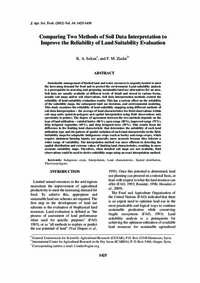Comparing Two Methods of Soil Data Interpretation to Improve the Reliability of Land Suitability Evaluation

Authors:
Sustainable management of limited land and water resources is urgently needed to meet the increasing demand for food and to protect the environment. Land suitability analysis is a prerequisite in assessing and proposing sustainable land use alternatives for an area. Soil data are usually available at different levels of detail and stored in various forms, usually soil maps and/or soil observations. Soil data interpretation methods control the reliability of land suitability evaluation results. This has a serious effect on the reliability of the suitability maps, the subsequent land use decisions, and environmental modeling. This study examines the reliability of land suitability mapping using different methods of soil data interpretation – the average of land characteristics for field observations within soil map units (point-in-polygon) and spatial interpolation using field observations only (proximity to points). The degree of agreement between the two methods depends on the type of land utilization – rainfed barley (86%), open range (85%), improved range (75%), drip irrigated vegetables (69%), and drip irrigated trees (59%). This results from the difference in the limiting land characteristic that determines the suitability of each land utilization type and the pattern of spatial variation of each land characteristic in the field. Suitability maps for adaptable (indigenous) crops (such as barley and range crops), which require minimum farming inputs, are generally more accurate because they tolerate a wider range of variability. The interpolation method was more efficient in detecting the spatial distribution and extreme values of limiting land characteristics, resulting in more accurate suitability maps. Therefore, when detailed soil maps are not available, field observations could be used to derive suitability maps using an exact interpolation method.
